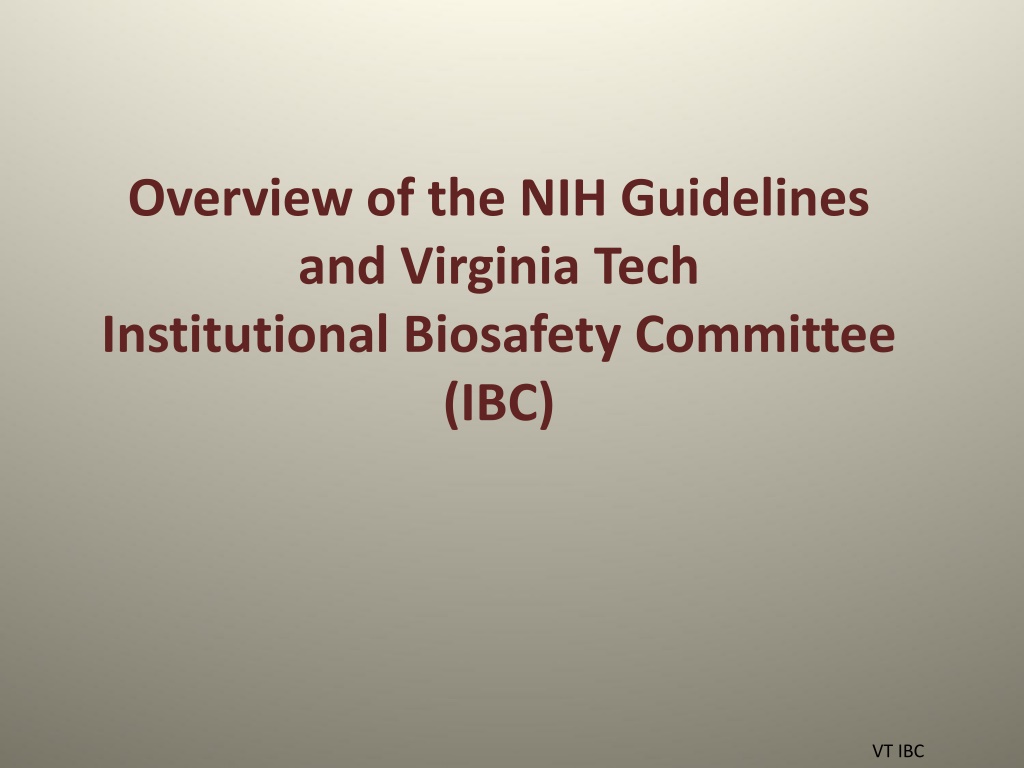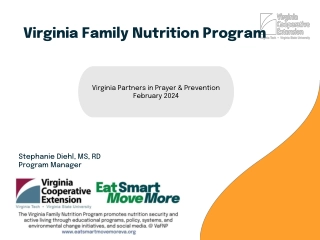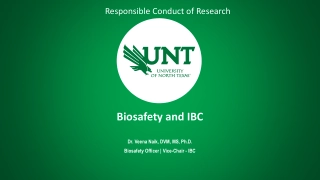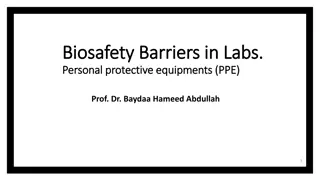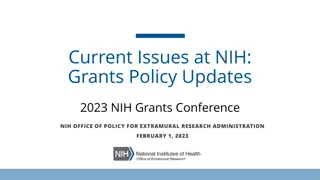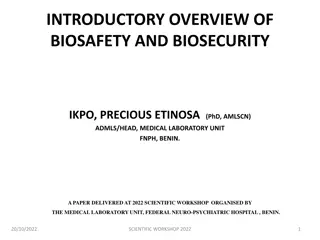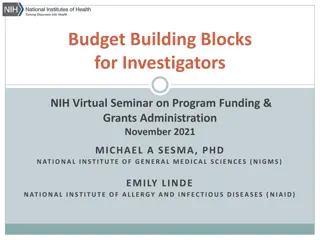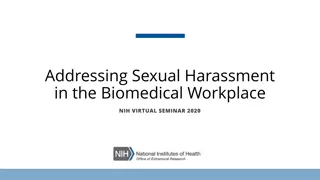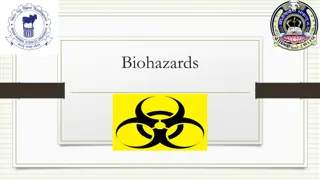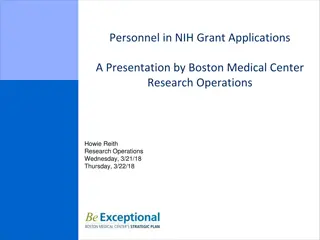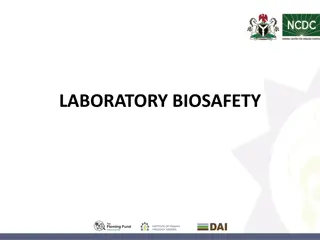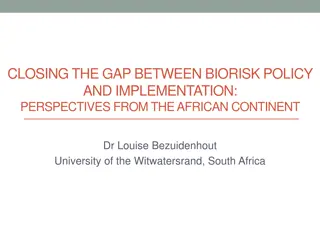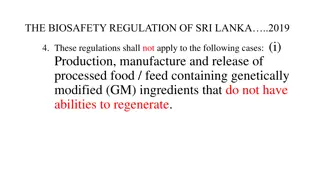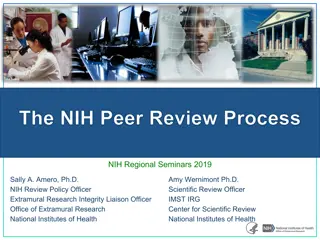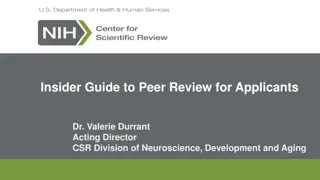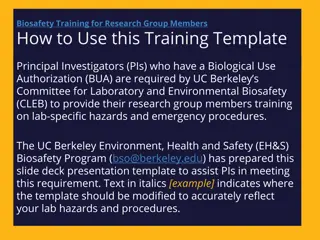Understanding NIH Guidelines and Virginia Tech's Institutional Biosafety Committee
The NIH Guidelines and Virginia Tech's Institutional Biosafety Committee play crucial roles in ensuring safety and compliance in research involving recombinant and synthetic nucleic acids. The guidelines outline biosafety practices and procedures, while the committee oversees the establishment of policies for safe laboratory activities. Non-compliance can lead to consequences like suspension of funding and project termination. Safety considerations, risk groups, and biosafety containment levels are also addressed.
Download Presentation

Please find below an Image/Link to download the presentation.
The content on the website is provided AS IS for your information and personal use only. It may not be sold, licensed, or shared on other websites without obtaining consent from the author. Download presentation by click this link. If you encounter any issues during the download, it is possible that the publisher has removed the file from their server.
E N D
Presentation Transcript
Overview of the NIH Guidelines and Virginia Tech Institutional Biosafety Committee (IBC) VT IBC
Institutional Biosafety Committee The Institutional Biosafety Committee (IBC) is involved in the establishment of biosafety policies that are used by Virginia Tech instructional and experimental research personnel to safely conduct activities involving recombinant and synthetic nucleic acid molecules, genetically modified microorganisms, plants and animals, artificial gene transfer, infectious agents and biologically derived toxins. The IBC ensures that all instructional and research laboratory activities are conducted in compliance with requirements and federally mandated guidelines, such as those outlined by the National Institutes of Health (NIH), Centers for Disease Control and Prevention (CDC), US Department of Agriculture (USDA), Occupational Safety and Health Administration (OSHA) and Virginia Tech. The IBC is a fundamental component of the NIH Guidelines for Research Involving Recombinant or Synthetic Nucleic Acid Molecules (commonly referred to as the NIH Guidelines).
NIH Guidelines what are they? The NIH Guidelines are a standard set of rules that are to be followed by anyone working on research or teaching experiments involving recombinant and/or synthetic nucleic acids. The Guidelines specify appropriate biosafety practices and procedures that need to be used. The NIH Guidelines outline the practices that must be followed when creating and handling recombinant and/or synthetic nucleic acids; as well as any organisms containing recombinant and/or synthetic nucleic acids. Recombinant and/or synthetic nucleic acids refer to: i. molecules that are constructed by joining nucleic acid molecules, and that can replicate in a living cell ii. nucleic acid molecules that are chemically or by other means synthesized or amplified, including those that are chemically or otherwise modified but can base pair with naturally occurring nucleic acid molecules iii. molecules that result from the replication of those described in (i) or (ii) above.
NIH Guidelines Who is affected? The NIH Guidelines ensure that everyone shares the same understanding regarding safety considerations, the types of experiments covered by the NIH Guidelines, and the roles and responsibilities of everyone associated with recombinant and/or synthetic nucleic acids (rsNA) research. The NIH Guidelines apply to any institution receiving NIH funding for rsNA research. If rsNA research is not in compliance with the guidelines: a. NIH funding can be suspended or terminated for the non- compliant project. b. NIH funding can be suspended or terminated for ALL NIH funded projects that involve recombinant and/or synthetic nucleic acids at the institution. c. All future projects involving recombinant and/or synthetic nucleic acids may require NIH approval prior to beginning any work.
Safety Considerations Risk Groups (RG) and biosafety containment levels (BSL) a. There are 4 levels of both risk groups and biosafety containment; RG-(1-4) and BSL-(1-4). Level 1 is the lowest. b. Risk Groups categorize biological agents by the potential risk associated with its use (NIH Guidelines Appendix B). c. Biosafety containment levels describe the specific equipment, practices and facilities that must be used for containment of biological agents (NIH Guidelines Appendix G). a. When referring to agents that have been introduced to rsNA, we use BL-1-4 to designate the containment level required to work with that agent. The BL level requirements are the same as those for the BSL designation. d. The RG designation may differ from the BSL required. Containment is both physical and biological a. Physical includes techniques, equipment and facilities used to contain the rsNA in the lab. b. Biological includes the survival and transmission ability of the rsNA and organisms outside of the lab.
Safety Considerations, continued Some agents and/or conditions require special containment practices, and the NIH Guidelines provides special designations and appendices to address the facility requirements for the agents involved: a. Large Cultures a. Appendix K describes the containment and facility requirements for recombinant/synthetic nucleic acid work involving large scale cultures (>10L). b. This work is designated as BL-(1-4)-LG b. Plants a. Appendix L describes the containment and facility requirements for recombinant/synthetic nucleic acid work involving plants housed in greenhouses. b. This work is designated as BL-(1-4)-P c. Animals a. Appendix M describes the containment and facility requirements for recombinant/synthetic nucleic acid work involving animals housed outside of standard animal containment. Typically, this involves using a room as the primary containment unit, rather than a cage or isolator. Commonly, these requirements are used for large/farm animals, but can apply to any animal. b. This work is designated as BL-(1-4)-N
Safety Considerations Risk Groups Risk Group Definition Examples Agents that are not associated with disease in healthy adult humans Bacillus subtilis 1 Agents that are associated with human disease which is rarely serious and for which preventive or therapeutic interventions are often available Salmonella 2 Agents that are associated with serious or lethal human disease for which preventive or therapeutic interventions may be available (high individual risk but low community risk) Prions, HIV types 1 and 2 3 Lassa virus, Ebola virus; NOT permitted at Virginia Tech Agents that are likely to cause serious or lethal human disease for which preventive or therapeutic interventions are not usually available (high individual risk and high community risk) 4
NIH Guidelines Experiments The NIH recognizes 6 rsNA review sections/categories: 1. Experiments requiring NIH Director and IBC approval prior to initiation. 2. Experiments requiring IBC and NIH Office of Science Policy approval prior to initiation. 3. Experiments requiring IBC and Virginia Tech Institutional Review Board (IRB) approval prior to participant enrollment. 4. Experiments requiring IBC approval prior to initiation. 5. Experiments requiring IBC notice at initiation. 6. Experiments exempt from the NIH Guidelines. Virginia Tech requires that all research involving recombinant and/or synthetic nucleic acids is registered with the Virginia Tech IBC, regardless of the NIH review category.
Section III-A Experiments, considered to be Major Actions, that require NIH Director approval and Virginia Tech IBC approval. Experiments involving the deliberate transfer of a drug resistance trait to microorganisms that are not known to acquire the trait naturally, if such acquisition could compromise the ability to control disease agents in humans, veterinary medicine, or agriculture.
Section III-B Experiments that require NIH Office of Science Policy and Virginia Tech IBC approval. III-B-1 regulates experiments involving the cloning of toxin molecules with an LD50 of less than 100 nanograms/kilogram of body weight. III-B-2 regulates experiments that have previously been approved as Major Actions (Section III-A) under the NIH Guidelines. The NIH Director will determine if III-B-2 is applicable.
Section III-C Experiments that require Virginia Tech IBC and Virginia Tech IRB approvals. III-C-1 regulates experiments involving the deliberate transfer of recombinant or synthetic nucleic acid molecules, or DNA or RNA derived from recombinant or synthetic nucleic acid molecules, into one or more human research participants.
Section III-D Experiments that require Virginia Tech IBC approval. III-D-1 regulates experiments that involve the use of RG-2, RG-3, RG-4, or restricted agents as host-vector systems. Restricted agents are designated by the USDA. III-D-2 regulates experiments in which DNA from RG-2, RG-3, RG-4, or restricted agents is cloned into non-pathogenic prokaryotic, or lower eukaryotic, host-vector systems. III-D-3 regulates experiments involving the use of infectious DNA or RNA viruses, or defective DNA and/or RNA viruses in the presence of helper virus, in tissue culture systems.
Section III-D, continued III-D-4 regulates experiments involving whole animals in which the animal's genome has been altered by stable introduction of recombinant or synthetic nucleic acid molecules, or nucleic acids derived therefrom, into the germ-line (transgenic animals), as well as experiments involving viable recombinant or synthetic nucleic acid molecule-modified microorganisms tested on whole animals, which must be conducted using a minimum containment level of BL-2. III-D-5 regulates experiments to genetically engineer whole plants by recombinant or synthetic nucleic acid molecule methods, to use such plants for other experimental purposes (e.g., response to stress), to propagate such plants, or to use plants together with microorganisms or insects containing recombinant or synthetic nucleic acid molecules; if the experiments involve agents requiring BL-2 containment.
Section III-D, continued III-D-6 regulates experiments involving the generation of more than 10 Liters of culture, at any one time. III-D-7 regulates experiments involving Influenza viruses.
Section III-E Experiments requiring Virginia Tech IBC approval. III-E regulates experiments not included in Sections III-A, B, C, D, F, and/or their subsections. III-E-1 regulates experiments involving the formation of recombinant or synthetic nucleic acid molecules containing no more than 2/3 of the genome of any eukaryotic virus. III-E-2 regulates experiments involving nucleic acid molecule-modified whole plants, and/or experiments involving recombinant or synthetic nucleic acid molecule-modified organisms associated with whole plants, except those that fall under Section III-A, III-B, III-D or III-F. These experiments do not involve the use of exotic plants and/or noxious weeds.
Section III-E, continued III-E-3 regulates experiments involving the generation of rodents in which the animal's genome has been altered by stable introduction of recombinant or synthetic nucleic acid molecules, or nucleic acids derived therefrom, into the germ-line (transgenic rodents). Only experiments that require BL1 containment are covered under this section; experiments that require BL2, BL3, or BL4 containment are covered under III-D-4, Experiments Involving Whole Animals .
Section III-F Experiments requiring Virginia Tech IBC approval. III-F regulates experiments involving recombinant or synthetic nucleic acid molecules that are exempt from the NIH Guidelines. III-F-1: Involving synthetic nucleic acids that: (1) can neither replicate nor generate nucleic acids that can replicate in any living cell (e.g., oligonucleotides or other synthetic nucleic acids that do not contain an origin of replication or contain elements known to interact with either DNA or RNA polymerase), and (2) are not designed to integrate into DNA, and (3) do not produce a toxin that is lethal for vertebrates at an LD50 of less than 100 nanograms per kilogram body weight. III-F-2: Involving rsNA that are not in organisms, cells, or viruses and that have not been modified or manipulated to render them capable of penetrating cellular membranes.
Section III-F, continued III-F-3: Involving rsNA that consist solely of the exact recombinant or synthetic nucleic acid sequence from a single source that exists contemporaneously in nature. III-F-4: Involving rsNA that consist entirely of nucleic acids from a prokaryotic host, including its indigenous plasmids or viruses when propagated only in that host (or a closely related strain of the same species), or when transferred to another host by well-established physiological means. III-F-5: Involving rsNA that consist entirely of nucleic acids from a eukaryotic host including its chloroplasts, mitochondria, or plasmids (but excluding viruses) when propagated only in that host (or a closely related strain of the same species).
Section III-F, continued III-F-6: Involving rsNA that consist entirely of nucleic acid segments from different species that exchange nucleic acids by known physiological processes, though one or more of the segments may be a synthetic equivalent. III-F-7: Involving genomic DNA molecules that have acquired a transposable element, provided the transposable element does not contain any recombinant and/or synthetic DNA. III-F-8: Involving rsNA experiments that do not present a significant risk to health or the environment (see NIH Guidelines Appendix C).
Responsibilities of the VT Principal Investigator (PI) In regards to IBC protocol submissions, the PI shall Make an initial assessment of the risk groups and containment levels required to safely conduct the research in the protocol. Select the appropriate microbiological and lab techniques. Submit the completed protocol, as well as subsequent changes, to the IBC for review and approval or disapproval. Maintain active communication with the IBC throughout the conduct of the research. Prior to beginning the research (after IBC approval), the PI shall make all protocols and lab manuals available to all personnel, describing the potential biohazards of the work. Instruct and train all personnel in practices and techniques required to ensure safety; and in the procedures for dealing with accidents. Maintain written documentation of personnel training. Inform all personnel of the reasons and provisions for any precautionary medical practices that are advised or requested (e.g. vaccinations, serum collection).
Responsibilities of the VT PI (continued) During the conduct of the research, the PI shall Supervise the safety performance of all personnel, to ensure that the required safety practices and techniques are employed. Investigate and report any potential exposure, accident, or incident pertaining to the operation and implementation of containment practices and procedures The Biosafety Officer (BSO) must be informed, immediately The following people/departments must be notified, in writing: BSO, IBC Program Office (ibc@vt.edu), greenhouse/animal facility manager, NIH Office of Science Policy (the IBC Program Office and BSO will help the PI submit this report). Correct work errors and conditions that may result in the release of recombinant and/or synthetic nucleic acid molecules. Ensure the integrity of physical and biological containment in the lab(s). Comply with reporting requirements for human gene transfer experiments.
Virginia Tech IBC The purpose of the Virginia Tech IBC is to ensure the health and safety of all personnel working with biohazardous agents. Virginia Tech research and teaching faculty are responsible for registering all work involving biohazardous agents. Information regarding the biohazardous agents overseen by the Virginia Tech IBC can be found on the IBC website (https://www.research.vt.edu/ibc.html), or by contacting the IBC Program Director (ibc@vt.edu).
References Virginia Tech Institutional Biosafety Committee (IBC) website NIH Office of Science Policy website NIH Guidelines
Quiz Please complete the required online quiz, using the following link https://secure.research.vt.edu/orc_cert?cert=ibc_training
